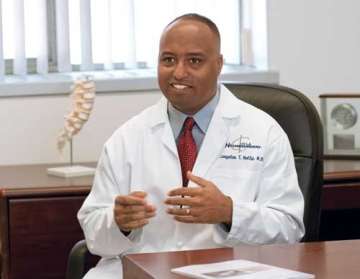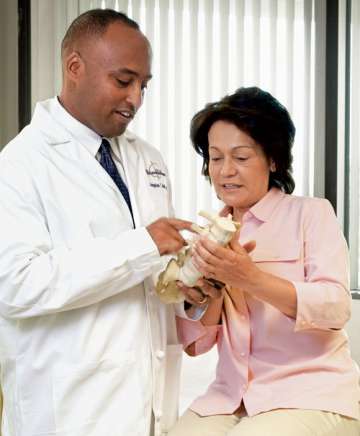Why Choose the UCLA Spine Center
Find your care
At the UCLA Health Spine Center, our experts diagnose, manage and treat all spinal injuries and conditions. Call 310-319-3475 to connect with a spine specialist.
Fax: 424-259-6560
UCLA Spine Center Draws Disciplines Together for Benefit of Patients
The UCLA Spine Center is unique among academic institutions in the way it brings together neurosurgery and orthopaedics, two traditionally separate practices, into a cohesive program to treat patients with degenerative and non-degenerative spinal conditions. The UCLA Spine Center, which includes neurosurgeons, orthopaedic surgeons and nonoperative specialists in physical medicine and rehabilitation, is located just several blocks away from the UCLA Santa Monica Medical Center. Neurosurgeon Langston Holly, MD, co-director of the Spine Center with orthopaedic surgeon Nick Shamie, MD, discusses how the facility benefits patients with clinical care and novel research programs.
How does the Spine Center’s facility in Santa Monica advance patient-centered care?

Historically, here at UCLA, our neurosurgeons and orthopaedic surgeons have worked together to treat our spine patients. The Spine Center brings even more disciplines together in one centralized location, which helps to streamline patient care. By being together in one location, we can hold our clinics at the same time, which provides patients with better continuity of care. If we want to discuss a challenging case or get a consensus on a treatment approach, we can easily meet together since we are all housed under the same roof. If one of our physiatrists encounters a patient that needs an immediate surgical evaluation, we can see the patient the same day while they are already here. The converse is true for a patient that we might see who is in extreme pain, but would be better treated with nonoperative therapy. Our physiatrists can also perform electromyography and nerve conduction studies within the Spine Center to help discern between conditions caused by a spinal or peripheral cause.
For the convenience of our patients, the Spine Center contains in-house radiology, so patients don’t need to leave the center to obtain their X-rays. We occupy the entire first floor of the building, and immediately above us is the UCLA Health 12th Street Physical Therapy facility. This state-of-the-art facility offers a wide range of physical therapy services, including a 4,000-square foot gym with virtual technology, specialized ultrasounds, force-plate equipment and orthotics services. This gym is great for our patients, because many of them need physical therapy rather than surgery. Almost all of our operative patients need some type of physical therapy after surgery, and this combined location makes visiting their surgeons and therapists much simpler. Lastly, we also have primary care physicians on the third floor of the building. This is particularly helpful for patients that do not have presently have a primary care physician or live a significant distance away from UCLA. We can immediately send these patients to one of our primary care physicians who can perform their preoperative clearance during the same visit. Working together, our medical team is able to quickly and seamlessly assist patients in one convenient place.
We also utilize a shared decision making algorithm for some of our most commonly encountered clinical conditions such as a herniated lumbar disc. The goal of shared decision-making is to help patients identify the treatment that best matches their individual references and goals. This includes the use of decision aids prior to their visit to help them better understand management options and minimize uncertainty in their ultimate treatment choice. We have found that patient satisfaction is significantly higher in patients that feel well informed about their condition as well as potential surgical and non-surgical options.
What is noteworthy about UCLA’s spine program?

UCLA surgeons were among the first in Southern California to treat pathologies of the spine with minimally invasive surgical techniques, which have radically improved patient recovery times. We also perform very large and complex surgeries for spinal deformity and tumors ranging from the skull base to the pelvis. We have a focus on quality and outstanding patient outcomes which has been documented and supported by a number of independent organizations and measurements. We have been among the leaders in the National Neurosurgery Quality and Outcomes Database that tracks surgical outcomes and postoperative readmission rate. Our readmission rates have also been documented to be among the lowest in the University Health System Consortium, an alliance of 120 academic medical centers and 299 of their affiliated hospitals representing the nation’s leading academic medical centers. Moreover, our Spine Center has been designated as a Blue Distinction Center for Spine Surgery for Quality and Cost by the Blue Cross Blue Shield Association due to our quality metrics and overall patient care. It is a true compliment that in addition to separate national outcome registries, a major insurance carrier has independently recognized our exceptional patient care.
In addition to our outstanding patient care, our focus on advancing research and science is very unique. Presently we receive over 2.5 million dollars in total National Institutes of Health (NIH) funding per year for spine related research. The NIH only supports the highest levels of scientific research, and is considered to be the gold standard for federal research funding and a hallmark of a successful research program. The vast majority of spine programs do not have any NIH funding. Our NIH funding started in 2009 and currently runs through 2023. We also have a number of pending research grants that we feel confident will be funded in the upcoming years.
How is the Spine Center currently contributing to the development of new therapies for patients with degenerative and non-degenerative disorders of the spine?
One of our most exciting therapies is the use of spinal cord electrical stimulation in quadriplegic patients to bypass the area of spinal cord injury and restore previously lost hand movement and function. This innovative work has largely been supported by funding from the NIH. We also have interests in repairing the damaged spinal cord utilizing dietary supplementation and nanotechnology. We utilize advanced imaging modalities – MR Spectroscopy, diffusion tensor imaging, and functional MRI to track the metabolic, microstructural, and functional changes in the brain and spinal cord as a way to detect spinal cord injury caused by degenerative spine disease before patients even become aware they have a problem. Using these same modalities, we can also predict which patients are likely to regain neurological function following certain surgeries. We have recently started to investigate the utility of machine learning to improve our ability to diagnose patients with various spinal disorders.
What is your long-term vision for the Spine Center?
We want to continue to provide patients with excellent, multidisciplinary care that is focused on high-quality clinical outcomes and patient satisfaction. As we continue to grow, we will seek ways to incorporate additional subspecialties that provide complementary spine related care. We want to continue to do the kind of leading-edge research we have always done. In the future, we hope to have even more of our novel research translated to the clinical setting where we can change treatment paradigms and improve the lives of our patients in unique ways. We will continue to train the next generation of physicians through our residency and post graduate fellowship training programs. We want to be an educational center for spine specialists in the community, across the nation and around the world.